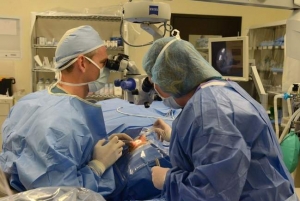By Amy Neff Roth of the Observer Dispatch
 Ophthalmologist Dr. Patrick Costello removes cataracts, performs laser eye surgery and does cosmetic eyelid procedures at the free-standing Griffiss Eye Surgery Center in Rome.
Ophthalmologist Dr. Patrick Costello removes cataracts, performs laser eye surgery and does cosmetic eyelid procedures at the free-standing Griffiss Eye Surgery Center in Rome.
He said the center, which opened about three years ago, offers patients cheaper, faster and more convenient care than a hospital.
“Everyone is highly specialized,” he explained. “Typically, I can do two-and-a-half times as many cases at the surgery center in the same amount of time. And I’m not operating any faster. It’s the turnover of the room and the efficiency.”
His center is not alone. Two more local ambulatory surgery centers are in the works: an orthopedic, plastic and pain surgery center in Westmoreland and another for pain management in either Utica or Kirkland.
The facilities are just the latest step in a decades-old march of services moving away from hospitals into community settings, whether that be an X-ray machine in an orthopedic surgeon’s office, chemotherapy in a doctor’s office or stitches in an urgent care center.
The availability of so many services in the community raises the question: Do we still need hospitals?
Anyone who’s ever had a heart attack knows the answer is yes — but not necessarily hospitals as we know them today.
“I think to a large extent if you say hospital, it is still the brick building that care goes on in (that people think of),” said Dr. John McCabe, CEO of Upstate University Hospital in Syracuse. “But the nature of that care is changing, and I think more and more, you’re seeing movement from the hospital to a care system.”
Growing competition for patients in money-making services, falling reimbursements for the services hospitals do provide and health care reform are pushing hospitals to change what they do, where they do it and how they do it.
Consumers in the middle
After the opening of the Griffiss Eye Surgery Center, the Mohawk Valley Health System – made up of St. Elizabeth Medical Center and Faxton St. Luke’s Healthcare – lost an estimated $11.4 million in profits between 2011 and 2013, officials estimate.
“It’s a lot of revenue that the hospital has lost and it’s a lot of profit,” said health system President and CEO Scott Perra.
That makes it harder, he said, for hospitals to offer another vital service to the community – access.
“The major difference between a medical office and a hospital is access,” said Dennis Whalen, president of the Hospital Association of New York State. “The hospital is open 24/7, 365 days a year. Anybody who walks into a hospital is required under the law to be treated, regardless of their ability to pay.”
That’s a concern echoed by Elisabeth Benjamin, a co-founder of Health Care for All New York. She said having more health care offered outside hospitals is in some ways good: It is more affordable and more convenient, she said. It also keeps patients seeking treatment for an injury, for example, away from sicker patients with dangerous germs.
But there’s a downside.
“I think the worry, from a consumer perspective is, No. 1, there’s less regulation and consumer protection in an outpatient facility, I would say, potentially,” she said. “And I think, No. 2, the idea of getting hospital financial aid or charity care, forget about that. You’re really on your own.”
Reinvention
Hospitals already have changed, cutting back on inpatient beds, expanding outpatient services and creating health systems that offer care outside hospital walls. Rome Memorial Hospital, for example, is a partner in the Griffiss eye center. The hospital needed more openings in its operating rooms and the relationship was deliberately structured to make sure the center didn’t harm hospital finances or services, said ophthalmologist Dr. John Costello.
These trends are likely to continue. And a relatively new phenomenon in the state could spread – free-standing emergency rooms, which already exist in Lake Placid and Sidney.
Health-care reform also is reshaping the mission of hospitals. Gone are the days when hospitals’ reason for existence was taking care of sick patients.
“The name of the game will be keeping people healthy, which it should have been for the past 40 years,” Perra said.
To do that, hospitals and other providers are forming networks, which likely are to keep getting bigger over time.
“The whole concept of accountable care organizations links providers together to focus on the delivery of care to a panel of patients,” said Jean Moore, director of the Center for Health Workforce Studies at the University at Albany. “It’s about ambulatory services; it’s about private practice; it’s about home care; it’s about long term care – that all these things have to be coordinated and working collaboratively to promote the health of patients.”
“I think for hospitals, the question is: How do we ensure we’re here in five years – or something’s here,” McCabe said, “so that care for the community for whom we’re responsible can go on?”




